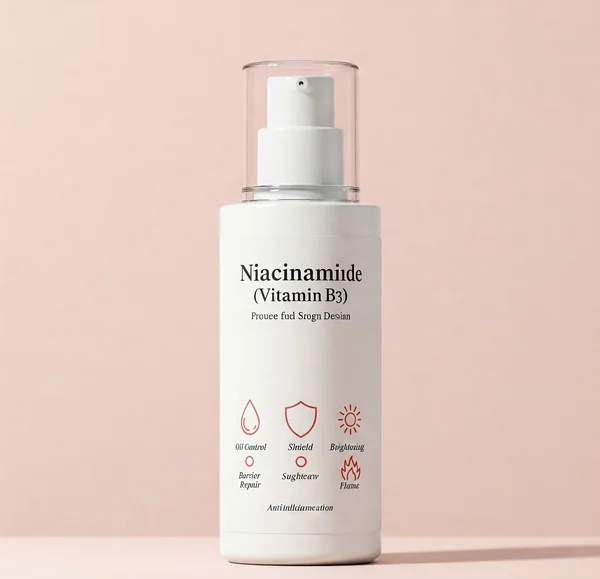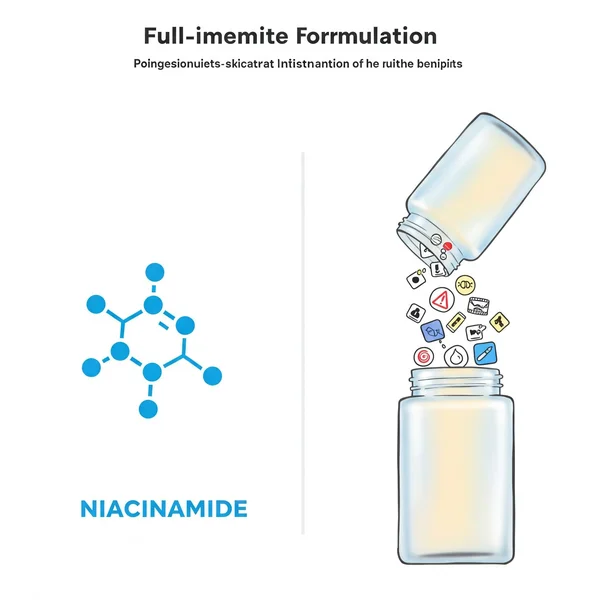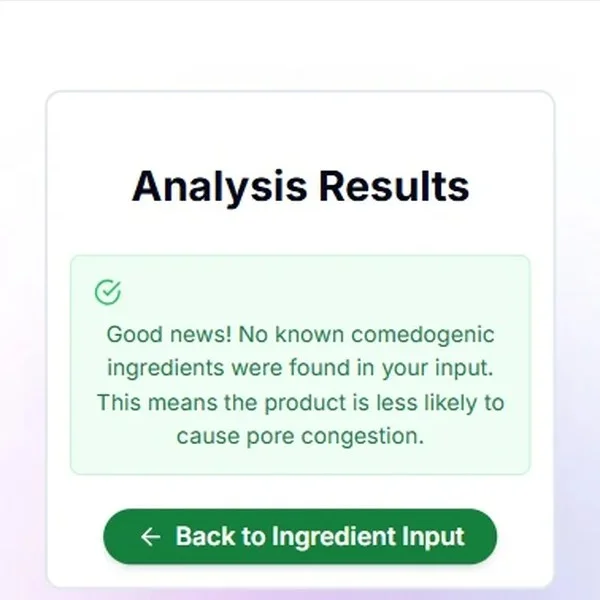ナイアシンアミドは毛穴を詰まらせるか?スキンケアの迷信を解き明かす
ナイアシンアミド。それは、あらゆる人の唇の上、そして無数の美容液、化粧水、保湿剤の中にあるスキンケア成分です。マルチタスクのパワーハウスとして称賛され、皮脂のコントロール、赤みの軽減から、より強い皮膚バリアまで、あらゆるものを約束します。しかし、称賛の中で、しつこい疑問が潜んでいます。ナイアシンアミドは毛穴を詰まらせるのか? 多くの人が導入後に吹き出物を経験したと報告しており、混乱と懸念につながっています。この記事では、このスキンケアの迷信を解き明かし、ナイアシンアミドと毛穴の背後にある真実を理解するお手伝いをするために、科学と一般的な経験を深く掘り下げます。この人気の成分について疑問に思っている場合は、いつでも当社のツールで製品の配合を確認できます。
ナイアシンアミドとは何か、そしてなぜこれほど人気なのか?
大きな問題に取り組む前に、ナイアシンアミドが実際には何かを理解しましょう。ナイアシンアミドは ビタミンB3 の一種であり、肌の健康全般において重要な役割を果たす必須栄養素です。その人気は単なる誇張ではなく、膨大な量の研究によって裏付けられています。
肌の健康のためのナイアシンアミドの主な利点
ナイアシンアミドの利点 は広範囲にわたり、さまざまな肌の悩みに対して多用途な成分となっています。
- 皮脂の調整: 皮脂の生成を調節するのに役立ち、オイリー肌や混合肌に有益です。
- 毛穴の目立たなくする: 肌の弾力を向上させ、皮脂をコントロールすることで、毛穴が目立たなくなります。
- 赤みと炎症を軽減: 抗炎症作用により、炎症を起こした肌を鎮静させ、酒さやニキビに関連する赤みを落ち着かせます。
- 皮膚バリア機能の改善: 皮膚の天然バリアを強化し、水分を保持し、環境からの攻撃から保護します。
- 色素沈着を薄くする: メラノソームの移動を抑制し、シミを薄くして肌の色を均一にします。
- 抗酸化作用: 肌をフリーラジカルのダメージから保護するのに役立ちます。

多くのスキンケアルーチンで定番となっている理由
幅広い利点と、ほとんどの肌タイプに対する一般的な許容性から、ナイアシンアミドが定番成分となっているのは驚くことではありません。複数の問題を同時に解決するため、ほとんどのスキンケアルーチンに効率的に追加できます。しかし、この広範な使用は、特に 毛穴を詰まらせる成分 である可能性に関するより多くの精査と疑問をもたらします。
大きな疑問:ナイアシンアミド自体は毛穴を詰まらせる成分か?
要点に直接行きましょう。ナイアシンアミド自体は毛穴を詰まらせる成分ですか?
科学的観点:ナイアシンアミドはコメドジェニックか?
純粋に科学的な観点から、純粋なナイアシンアミドは一般的に 非コメドジェニック と考えられています。つまり、その成分自体は、単離された形で、毛穴を詰まらせたり、直接コメド(黒ずみまたは白ずみ)を引き起こすことが知られていません。ほとんどの皮膚科学のリソースと成分データベースは、ナイアシンアミドを問題のある コメドジェニック 物質としてリストしていません。
逸話的な報告:なぜ一部のユーザーが吹き出物を経験するのか
科学にもかかわらず、オンラインで迅速に検索すると、ナイアシンアミドによって吹き出物が発生したと考えるユーザーからの多くの逸話的な報告が見つかります。これらの ナイアシンアミドによる吹き出物 は、一部の人にとっては現実の経験であるため、実際には何が起こっているのでしょうか?ナイアシンアミドなのか、それとも何か他のものなのか?
ナイアシンアミド製品を使用するときの吹き出物の潜在的な理由
ナイアシンアミド自体が通常犯人ではない場合、なぜナイアシンアミドを含む製品を使用すると、一部の人々がニキビやぶつぶつを経験するのでしょうか?これらの ナイアシンアミドの副作用 には、いくつかの潜在的な説明があります。
製品の配合:他の成分が原因の可能性がある
これは多くの場合、最も可能性の高い理由です。スキンケア製品は、多くの成分の複雑な混合物です。ナイアシンアミドが主役かもしれませんが、乳化剤、増粘剤、シリコーン、香料、その他のオイルやエステルを含む基本配合には、既知の 毛穴を詰まらせる成分 が含まれている可能性があります。有効成分だけでなく、すべての成分リストを見ることは重要です。完全な配合を分析するには、包括的な成分チェッカーが非常に役立ちます。

濃度が重要:高濃度が常に良いとは限らない
ナイアシンアミドは、通常、2%から5%の濃度で有効です。一部の製品は、はるかに高い濃度(10%、20%、またはそれ以上)を誇っています。より高濃度が常に良いとは限りませんが、非常に高濃度の 濃度 は、場合によっては特定の個人に刺激や敏感さを引き起こし、ニキビと間違えられる赤みやぶつぶつとして現れる可能性があります。
初期の肌の浄化と真の吹き出物の違い
ナイアシンアミドは浄化を引き起こす可能性がありますか? はい、一部の人にとっては。ナイアシンアミドは、肌の細胞のターンオーバーに影響を与える可能性があります。まだ見えない詰まった毛穴(マイクロコメド)が潜在している場合、細胞のターンオーバーを促進する成分は、これらをより迅速に表面に引き出し、吹き出物が一時的に増加する可能性があります。この「浄化」は通常、通常吹き出物が発生する領域で発生し、数週間以内に解消されるはずです。これは、毛穴を詰まらせる成分 または刺激によって引き起こされる真の吹き出物とは異なり、新しい領域に現れたり、持続したりする可能性があります。
肌の敏感さと刺激によるぶつぶつ
一部の人は、特に高濃度の場合、または製品の他の成分に対して、ナイアシンアミド自体に反応する 敏感肌 を持っている可能性があります。この刺激は、小さな赤いぶつぶつやニキビのように見えることがあります。
不適切な製品の使用または組み合わせ
一度に多くの新しい有効成分を使用したり、適切な導入なしにナイアシンアミドを他の強力な有効成分と組み合わせたりすると、肌に負担がかかり、刺激や吹き出物が発生する可能性があります。
ナイアシンアミドをルーチンに安全に組み込む方法
吹き出物のリスクを最小限に抑えながら ナイアシンアミドの利点 を得たい場合は、ニキビ予防 のアプローチとして次のヒントを検討してください。
低濃度からゆっくりと始める(パッチテストと段階的な導入)
低濃度のナイアシンアミド(例:2〜5%)を含む製品から始めます。新しい製品は、必ず小さな目立たない皮膚の部位に数日間パッチテストして、顔全体に塗布する前に副作用がないか確認してください。最初は2日に1回など、ルーチンに段階的に導入します。
完全な成分リストを確認する(当社の毛穴詰まりチェッカーを使用しましょう!)
これは強調してもしすぎることはありません。「ナイアシンアミド」のラベルだけに頼らないでください。すべての配合 を精査してください。オンライン成分分析ツールを使用して、製品に含まれるその他の潜在的に問題のあるまたは コメドジェニック な成分を特定します。

シンプルでよく配合されたベースの製品を選択する
特に敏感肌や ニキビができやすい肌 の場合は、シンプルで無香料の配合で知られる評判の良いブランドのナイアシンアミド製品を選択してください。
肌の声に耳を澄ませる:注意すべき兆候
肌がどのように反応するか注意してください。初期の使用時には軽いチクチク感がある場合がありますが、持続的な赤み、かゆみ、熱感、または吹き出物の悪化は、製品(または使用方法)があなたに合っていない兆候です。
ナイアシンアミドがあなたに適していないと疑う場合
ナイアシンアミドによる吹き出物 が本当のの問題であるかどうかをどのように判断しますか?上記のヒント(信頼できる製品成分チェッカーで完全な成分リストを確認し、低濃度からゆっくりと開始する)に従っていても、新しい領域に持続的な吹き出物が発生したり、治まらない重大な刺激が発生したりする場合は、特定の製品、またはまれにナイアシンアミド自体が、あなたの肌に適していない可能性があります。
ナイアシンアミド:毛穴の友達か敵か?
では、ナイアシンアミドは毛穴を詰まらせるのか? 圧倒的なコンセンサスは、純粋なナイアシンアミド自体は 非コメドジェニック であり、一般的に ニキビ予防 として考えられているということです。ナイアシンアミド製品を使用しても吹き出物が発生する場合は、犯人は多くの場合、配合 内の他の成分、肌にとって高すぎる 濃度、または初期の 肌の浄化 段階です。
この有益な成分を恐れることによって思いとどまらないでください。代わりに、情報に通じた消費者になりましょう。成分リストを精査し、当社の毛穴詰まりチェッカーが検討している製品の分析に役立つことを忘れないでください。ニュアンスを理解することで、あなた自身の肌に最適な選択をすることができます。
ナイアシンアミド製品で吹き出物を経験したことがありますか?あなたの経験はどうでしたか?あなたの考えを下のコメント欄で共有してください!
ナイアシンアミドと毛穴の詰まりに関するよくある質問
ユーザーがよく尋ねる質問をいくつか紹介します。
Q1:ナイアシンアミドは毛穴を詰まらせない場合でも、浄化を引き起こす可能性がありますか?
ナイアシンアミドは浄化を引き起こす可能性がありますか? はい。ナイアシンアミドは肌の細胞のターンオーバーに影響を与える可能性があり、ニキビの発症に影響を与える抗炎症作用があるため、潜在的なマイクロコメドがより迅速に表面に現れる初期の「浄化」段階をトリガーすることがあります。これは一時的なものであり、製品が毛穴を詰まらせることとは異なります。
Q2:安全で効果的とされるナイアシンアミドの割合は?
ナイアシンアミドの安全な割合は? ほとんどの研究では、2%から5%の濃度で ナイアシンアミドの利点 が有効であることが示されています。より高い濃度(10%以上)も入手可能ですが、特に 敏感肌 の人にとっては刺激の可能性が高くなります。低濃度から始めるのが一般的におすすめです。
Q3:ナイアシンアミドを含む製品で吹き出物が発生した場合、ナイアシンアミドを永遠に避けるべきですか?
必ずしもそうではありません。まず、成分リストアナライザーを使用して、他の潜在的な原因となる製品のすべての配合を確認してください。問題を引き起こしているのは別の 毛穴を詰まらせる成分 かもしれません。低濃度のナイアシンアミドまたはよりシンプルな基本配合の別の製品を試すこともできます。
Q4:吹き出物の原因がナイアシンアミドなのか、他の成分なのかをどのように判断できますか?
これは難しい場合があります。製品が原因であると疑う場合は、使用を中止して肌が改善するかどうかを確認します。再導入して吹き出物が再発する場合は、その製品に問題がある可能性があります。ナイアシンアミドを特定するには、理想的には、包括的な成分チェッカーで確認した後、ナイアシンアミドを主要な有効成分とし、他の潜在的な刺激物質が少ない非常にシンプルな配合を試す必要があります。パッチテストも重要です。
Q5:ナイアシンアミドはニキビができやすい肌に良いですか?
ナイアシンアミドはニキビに良いですか? 一般的には、はい。その抗炎症作用、皮脂を調整する能力、そして皮膚バリアを強化する役割は、ニキビができやすい肌 にとって非常に有益です。重要なのは、他の コメドジェニック な成分を含まず、正しく導入された適切に配合された製品を選択することです。